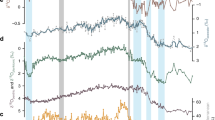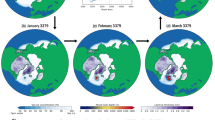Abstract
A great deal of palaeoenvironmental and palaeoclimatic evidence suggests that a predominant temperature drop and an aridification occurred at ca. 4.0 ka BP. Palaeoclimate studies in China support this dedution. The collapse of ancient civilizations at ca. 4.0 ka BP in the Nile Valley and Mesopotamia has been attributed to climate-induced aridification. A widespread alternation of the ancient cultures was also found in China at ca. 4.0 ka BP in concert with the collapse of the civilizations in the Old World. Palaeoclimatic studies indicate that the abrupt climate change at 4.0 ka BP is one of the realizations of the cold phase in millennial scale climate oscillations, which may be related to the modulation of the Thermohaline Circulation (THC) over the Atlantic Ocean. Therefore, this study conducts a numerical experiment of a GCM with SST forcing to simulate the impact of the weakening of the THC. Results show a drop in temperature from North Europe, the northern middle East Asia, and northern East Asia and a significant reduction of precipitation in East Africa, the Middle East, the Indian Peninsula, and the Yellow River Valley. This seems to support the idea that coldness and aridification at ca. 4.0 ka BP was caused by the weakening of the THC.
Similar content being viewed by others
References
Alley, R. B., P. U. Clark, L. D. Keigwin, and R. S. Webb, 1999: Making sense of millennial-scale climate change. Mechanisms of global climate change at millennial time scales, Clark, P. U. et al., Eds., Washington, D C: AGU, 385–394.
Bond, G. C., W. Showers, M. Elliot, M. Evans, R. Lotti, I. Hajdas, G. Bonani, and S. Johson, 1999: The North Atlantic.s 1–2 kyr climate rhythm: Relation to Heinrich events, Dansgaard/Oeschger cycles and the Little Ice Age.Mechanisms of Global Climate Change at Millennial Time Scales, P. U. Clark et al., Eds. Washington, D C: AGU, 35–38.
Brown, D. M., Ed., 2002:Ancient India: Land of Mystery, Lost Civilizations. Vol. 3, Time-Life Inc., Chinese translation by Li Xuyin, Hua Xia Publishing House and Guanxi Peoples Publishing House, Beijing, 197pp.
Group of Experts, 2000:Project of Chronology Studies on the Xia, Shang and Zhou Dynasties-Report of AD. 1996–2000: Simplified Version. World Book Press, Beijing, 86–88. (in Chinese)
Kenoyer, M., 1998:Ancient Cities of Indus Valley Civilization. Oxford University Press, London, Chinese translation by Zhang Chunxu, Zhejiang People Press, Hangzhou, 2000, 363pp.
Kiehl, J. T., J. J. Hack, G. B. Bonan, B. A. Boville, B. P. Briegleb, D. L. Williamson, and P. J. Rasch, 1996: Description of the NCAR Community Climate Model (CCM3). NCAR Tech. Note, 152pp. [Available from the NCAR CCM3 web site http://www.cgd.ucar.edu/cms/ccm3].
Kiehl, J. T., J. J. Hack, G. B. Bonan, B. A. Boville, D. L. Williamson, and P. J. Rasch, 1998: The National Center for Atmospheric Research Community Climate Model: CCM3.J. Climate,11, 1131–1149.
Kong Shaochen, Du Naiqiu, Xu Qinghai, and Tong Guobang, 1992: Palaeoclimatic variations of flora in North China during the Megathermal of the Holocene.Holocene Megathermal Climate and Environment in China, Shi Yafeng and Kong Shaochen, Eds., China Ocean Press, Beijing, 48–65. (in Chinese)
Kukla, G., H. N. Dalfes, and H. Weiss, 1997: Preface.Third Millennium BC Climate Change and the Old World Social Collapse, H. N. Dalfes et al., Eds., Springe-Verlag, Berlin Heidelberg: V-VII.
Manabe, S., and R. J. Stouffer, 2000: Study of abrupt climate change by a coupled ocean-atmosphere model.Quaternary Science Review,19, 285–299.
Qiu Shihua, Chen Tiemei, and Cai Lianzhen, Eds., 1990:14CChronological Research in China. Science Press, Beijing, 1–366. (in Chinese)
Suzuki Hideo, 1979: 3500 years ago-climatic changes and ancient civilizations. Bulletin of the Department of Geography, University of Tokyo,11, 43–58.
Vertenstein, M., Kluzek E. B., User’s Guide to LSM1.1, Climate and Global Dynamics Division, National Center for Atmospheric Research Boulder, Colorado, 1–30pp. [Available from the NCAR CCM3 Web site: http://www.cgd.ucar.edu/cms/ccm3/ccm3lsm.doc/lsmdoc/].
Wang Huijun, 2002: The Mid-Holocene climate simulated by a grid-point AGCM coupled with a Biome Model.Adv. Atmos. Sci.,19(2), 205–218.
Wang Shaowu, and Xie Zhihui, 2002: Climate variability at millennial time scales.Earth Science Frontiers,9, 143–152. (in Chinese)
Watson, R., J. Houghton, and Ding Yihui, 2001: Climate Change 2001. The Scientific Basis, Summary for policymakers and technical summary of the working group 1 report. WMO. UNEP, 1–98.
Weiss, H., 1993: The genesis and collapse of third millennium North Mesopotamian civilization.Science,262, 995–1004.
Weiss, H., 1997: Late third millennium abrupt climate change and social collapse in West Asia and Egypt.Third Millennium BC Climate Change and the Old World Social Collapse, H. N. Dalfes et al., Eds., Springer-Verlag, Berlin Heidelberg, 711–723.
Weiss, H., and R. S. Bradlley, 2001: What drives societal collapse.Science,296, 609.
Wu Wenxiang, and Liu Tungsheng, 2001: 5,500 a BP climatic event and its implications for the emergence of civilizations in Egypt and Mesopotamia and neolothic cultural development in China.Quaternary Sciences,21, 443–451. (in Chinese)
Yang Huairen, 1993: Palaeomonsoon, mid Holocene deluges and sea level changes in China.Climatological Studies-Climatic and Chinese Climatic Issues, Yao Zhensheng, Ed., China Meteorological Press, Beijing, 194–204. (in Chinese)
Yu Ge, Chen Xing, Liu Jian, and Wang Sumin, 2000: Modeling and diagnosis on climate in East Asia during LGM.Chinese Science Bulletin,45(20), 2153–2159. (in Chinese)
Zhao Bele, 1999: The Endless Nivana. Yunnan People Press, Kunming, 211pp. (in Chinese)
Author information
Authors and Affiliations
Corresponding author
Rights and permissions
About this article
Cite this article
Wang, S., Zhou, T., Cai, J. et al. Abrupt climate change around 4 ka BP: Role of the Thermohaline circulation as indicated by a GCM experiment. Adv. Atmos. Sci. 21, 291–295 (2004). https://doi.org/10.1007/BF02915716
Received:
Revised:
Issue Date:
DOI: https://doi.org/10.1007/BF02915716




